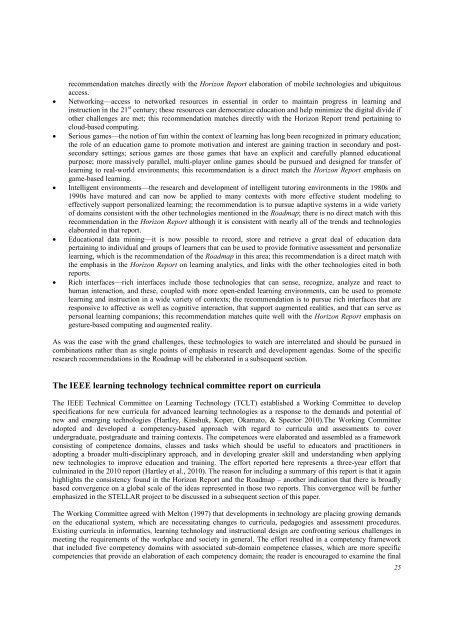Download Complete Issue in PDF - Educational Technology & Society
Download Complete Issue in PDF - Educational Technology & Society
Download Complete Issue in PDF - Educational Technology & Society
You also want an ePaper? Increase the reach of your titles
YUMPU automatically turns print PDFs into web optimized ePapers that Google loves.
ecommendation matches directly with the Horizon Report elaboration of mobile technologies and ubiquitous<br />
access.<br />
• Network<strong>in</strong>g—access to networked resources <strong>in</strong> essential <strong>in</strong> order to ma<strong>in</strong>ta<strong>in</strong> progress <strong>in</strong> learn<strong>in</strong>g and<br />
<strong>in</strong>struction <strong>in</strong> the 21 st century; these resources can democratize education and help m<strong>in</strong>imize the digital divide if<br />
other challenges are met; this recommendation matches directly with the Horizon Report trend perta<strong>in</strong><strong>in</strong>g to<br />
cloud-based comput<strong>in</strong>g.<br />
• Serious games—the notion of fun with<strong>in</strong> the context of learn<strong>in</strong>g has long been recognized <strong>in</strong> primary education;<br />
the role of an education game to promote motivation and <strong>in</strong>terest are ga<strong>in</strong><strong>in</strong>g traction <strong>in</strong> secondary and postsecondary<br />
sett<strong>in</strong>gs; serious games are those games that have an explicit and carefully planned educational<br />
purpose; more massively parallel, multi-player onl<strong>in</strong>e games should be pursued and designed for transfer of<br />
learn<strong>in</strong>g to real-world environments; this recommendation is a direct match the Horizon Report emphasis on<br />
game-based learn<strong>in</strong>g.<br />
• Intelligent environments—the research and development of <strong>in</strong>telligent tutor<strong>in</strong>g environments <strong>in</strong> the 1980s and<br />
1990s have matured and can now be applied to many contexts with more effective student model<strong>in</strong>g to<br />
effectively support personalized learn<strong>in</strong>g; the recommendation is to pursue adaptive systems <strong>in</strong> a wide variety<br />
of doma<strong>in</strong>s consistent with the other technologies mentioned <strong>in</strong> the Roadmap; there is no direct match with this<br />
recommendation <strong>in</strong> the Horizon Report although it is consistent with nearly all of the trends and technologies<br />
elaborated <strong>in</strong> that report.<br />
• <strong>Educational</strong> data m<strong>in</strong><strong>in</strong>g—it is now possible to record, store and retrieve a great deal of education data<br />
perta<strong>in</strong><strong>in</strong>g to <strong>in</strong>dividual and groups of learners that can be used to provide formative assessment and personalize<br />
learn<strong>in</strong>g, which is the recommendation of the Roadmap <strong>in</strong> this area; this recommendation is a direct match with<br />
the emphasis <strong>in</strong> the Horizon Report on learn<strong>in</strong>g analytics, and l<strong>in</strong>ks with the other technologies cited <strong>in</strong> both<br />
reports.<br />
• Rich <strong>in</strong>terfaces—rich <strong>in</strong>terfaces <strong>in</strong>clude those technologies that can sense, recognize, analyze and react to<br />
human <strong>in</strong>teraction, and these, coupled with more open-ended learn<strong>in</strong>g environments, can be used to promote<br />
learn<strong>in</strong>g and <strong>in</strong>struction <strong>in</strong> a wide variety of contexts; the recommendation is to pursue rich <strong>in</strong>terfaces that are<br />
responsive to affective as well as cognitive <strong>in</strong>teraction, that support augmented realities, and that can serve as<br />
personal learn<strong>in</strong>g companions; this recommendation matches quite well with the Horizon Report emphasis on<br />
gesture-based comput<strong>in</strong>g and augmented reality.<br />
As was the case with the grand challenges, these technologies to watch are <strong>in</strong>terrelated and should be pursued <strong>in</strong><br />
comb<strong>in</strong>ations rather than as s<strong>in</strong>gle po<strong>in</strong>ts of emphasis <strong>in</strong> research and development agendas. Some of the specific<br />
research recommendations <strong>in</strong> the Roadmap will be elaborated <strong>in</strong> a subsequent section.<br />
The IEEE learn<strong>in</strong>g technology technical committee report on curricula<br />
The IEEE Technical Committee on Learn<strong>in</strong>g <strong>Technology</strong> (TCLT) established a Work<strong>in</strong>g Committee to develop<br />
specifications for new curricula for advanced learn<strong>in</strong>g technologies as a response to the demands and potential of<br />
new and emerg<strong>in</strong>g technologies (Hartley, K<strong>in</strong>shuk, Koper, Okamato, & Spector 2010).The Work<strong>in</strong>g Committee<br />
adopted and developed a competency-based approach with regard to curricula and assessments to cover<br />
undergraduate, postgraduate and tra<strong>in</strong><strong>in</strong>g contexts. The competences were elaborated and assembled as a framework<br />
consist<strong>in</strong>g of competence doma<strong>in</strong>s, classes and tasks which should be useful to educators and practitioners <strong>in</strong><br />
adopt<strong>in</strong>g a broader multi-discipl<strong>in</strong>ary approach, and <strong>in</strong> develop<strong>in</strong>g greater skill and understand<strong>in</strong>g when apply<strong>in</strong>g<br />
new technologies to improve education and tra<strong>in</strong><strong>in</strong>g. The effort reported here represents a three-year effort that<br />
culm<strong>in</strong>ated <strong>in</strong> the 2010 report (Hartley et al., 2010). The reason for <strong>in</strong>clud<strong>in</strong>g a summary of this report is that it aga<strong>in</strong><br />
highlights the consistency found <strong>in</strong> the Horizon Report and the Roadmap – another <strong>in</strong>dication that there is broadly<br />
based convergence on a global scale of the ideas represented <strong>in</strong> those two reports. This convergence will be further<br />
emphasized <strong>in</strong> the STELLAR project to be discussed <strong>in</strong> a subsequent section of this paper.<br />
The Work<strong>in</strong>g Committee agreed with Melton (1997) that developments <strong>in</strong> technology are plac<strong>in</strong>g grow<strong>in</strong>g demands<br />
on the educational system, which are necessitat<strong>in</strong>g changes to curricula, pedagogies and assessment procedures.<br />
Exist<strong>in</strong>g curricula <strong>in</strong> <strong>in</strong>formatics, learn<strong>in</strong>g technology and <strong>in</strong>structional design are confront<strong>in</strong>g serious challenges <strong>in</strong><br />
meet<strong>in</strong>g the requirements of the workplace and society <strong>in</strong> general. The effort resulted <strong>in</strong> a competency framework<br />
that <strong>in</strong>cluded five competency doma<strong>in</strong>s with associated sub-doma<strong>in</strong> competence classes, which are more specific<br />
competencies that provide an elaboration of each competency doma<strong>in</strong>; the reader is encouraged to exam<strong>in</strong>e the f<strong>in</strong>al<br />
25

















